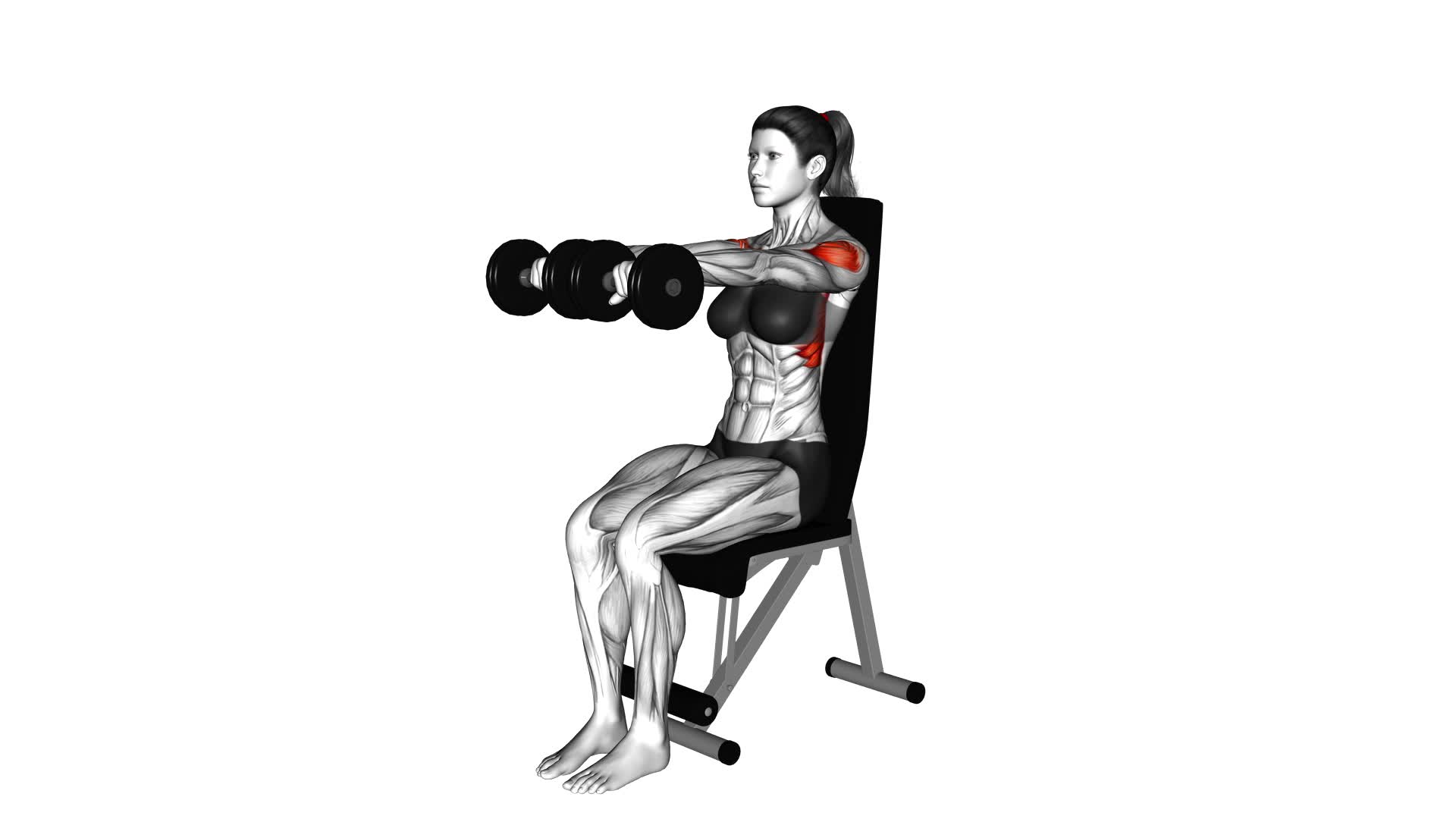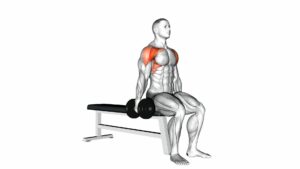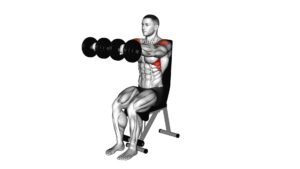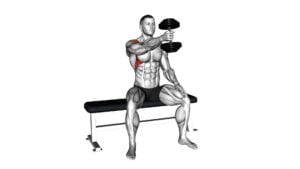Dumbbell Seated Front Raise (female) – Video Exercise Guide & Tips

Are you looking for an effective exercise to tone your shoulders and arms? Look no further than the dumbbell seated front raise!
Watch This Exercise Video
This exercise targets your front deltoids, helping you achieve strong and defined muscles. In this video exercise guide, we'll show you the proper form and technique, common mistakes to avoid, and variations to challenge yourself.
Get ready to add this exercise to your routine and see amazing results!
Key Takeaways
- Targets the anterior and lateral deltoids for improved shoulder stability and a well-rounded shoulder appearance
- Helps improve posture by strengthening the upper back and shoulder muscles
- Engages core muscles for stability and balance
- Provides a comprehensive shoulder workout targeting multiple muscle groups
Benefits of the Dumbbell Seated Front Raise
There are five key benefits of performing the dumbbell seated front raise. This exercise is great for improving shoulder strength and is an effective upper body workout.
Firstly, the dumbbell seated front raise targets the anterior deltoids, which are the muscles responsible for lifting your arms in front of your body. By strengthening these muscles, you can enhance your overall shoulder stability and prevent injuries.
Secondly, this exercise also engages the lateral deltoids, which are the muscles on the sides of your shoulders. By working these muscles, you can achieve a more well-rounded and defined shoulder appearance.
Additionally, the dumbbell seated front raise helps to improve posture by strengthening the upper back and shoulder muscles. This can alleviate common issues such as rounded shoulders and slouching.
Furthermore, this exercise can enhance your overall upper body strength and power, which can be beneficial for various daily activities and sports.
Lastly, the dumbbell seated front raise is a versatile exercise that can be easily modified by adjusting the weight or using different grip positions. This allows for progressive overload and continuous muscle growth and development.
Equipment Needed for the Exercise
To perform the Dumbbell Seated Front Raise exercise, you'll need a set of dumbbells. Choose a weight that challenges you but allows you to maintain proper form throughout the exercise.
If you don't have access to dumbbells, you can use alternative equipment like resistance bands or water bottles filled with sand or water. Always make sure that the equipment you use is in good condition and that you have enough space to perform the exercise safely.
Required Exercise Equipment
To perform the Dumbbell Seated Front Raise exercise, you'll need a set of dumbbells. Here are three items of exercise equipment that will help you complete this workout effectively:
- Dumbbells: Choose a weight that challenges you but still allows you to maintain proper form throughout the exercise. This will help you target and strengthen your shoulder muscles.
- Exercise Bench: Sit on a sturdy exercise bench with a backrest to provide support for your spine and maintain stability during the movement. Adjust the bench to a height that allows your feet to be flat on the ground.
- Exercise Mat: Place an exercise mat on the bench to provide cushioning and prevent discomfort while sitting. This will also help to absorb sweat and keep the bench clean.
Alternatives to Dumbbells
Using alternative exercise equipment can be a great option if you don't have access to dumbbells for the Dumbbell Seated Front Raise exercise. There are several alternative options you can consider for this exercise.
One substitution exercise is using resistance bands. These bands provide resistance and can be held in your hands to mimic the motion of the front raise.
Another option is using water bottles or canned goods as makeshift weights. While they may not provide as much resistance as dumbbells, they can still be effective for this exercise. Remember to choose a weight that challenges you but allows you to maintain proper form.
These alternative options can help you perform the Dumbbell Seated Front Raise even without dumbbells.
Now, let's move on to the next section and discuss safety precautions for equipment.
Safety Precautions for Equipment
When using alternative exercise equipment for the Dumbbell Seated Front Raise, it's important to take necessary safety precautions. Here are three key safety measures to consider:
- Choose the right weight: To prevent injuries, select a weight that challenges you without straining your muscles. Start with lighter weights and gradually increase as you build strength and confidence.
- Maintain proper form: Ensure your back is straight, shoulders are relaxed, and core is engaged throughout the exercise. Avoid excessive swinging or jerking motions, as this can strain your muscles and lead to injury.
- Use equipment with proper grips: Opt for dumbbells or alternative equipment with comfortable and secure handles. This will provide better control and minimize the risk of accidental slips or drops.
Proper Form and Technique
To perform the dumbbell seated front raise with proper form and technique, it's important to focus on shoulder alignment during the exercise. Keep your shoulders relaxed and avoid shrugging them up towards your ears.
Engaging your core for stability is also crucial, as it helps maintain proper posture and prevents excessive swinging or leaning during the movement.
Shoulder Alignment During Exercise
To maintain proper form and technique during the Dumbbell Seated Front Raise exercise, ensure that your shoulders are correctly aligned. Proper shoulder alignment is crucial for shoulder mobility and effective muscle activation. Here are three key points to remember:
- Keep your shoulders relaxed and down: Avoid shrugging your shoulders up towards your ears. Instead, focus on keeping them relaxed and pulled down throughout the exercise.
- Engage your shoulder blades: Squeeze your shoulder blades together behind you as you lift the dumbbells. This helps stabilize your shoulders and prevents excessive strain on your neck and upper back.
- Maintain a neutral spine: Keep your spine straight and avoid leaning forward or backward during the exercise. This ensures proper alignment and distributes the workload evenly across your shoulders.
Engaging Core for Stability
Ensure your core is engaged for stability during the Dumbbell Seated Front Raise exercise. Core engagement is essential for maintaining proper form and technique, as well as preventing injury. When performing this exercise, focus on tightening your abdominal muscles and drawing your navel towards your spine. This will activate your core and provide a solid foundation for the movement.
Engaging your core also helps to stabilize your body, allowing you to lift the dumbbells with control and precision. Stability training, such as core engagement during exercises like the Dumbbell Seated Front Raise, can improve overall strength and balance.
Remember to maintain core engagement throughout the entire exercise to maximize the benefits and ensure proper form.
Common Mistakes to Avoid
Avoid the common mistake of using too much weight during the Dumbbell Seated Front Raise exercise. While it may be tempting to go heavy, using excessive weight can compromise your form and increase the risk of injury.
To ensure that you perform the exercise correctly and maximize its benefits, keep the following tips in mind:
- Choose the right weight: Select a weight that allows you to maintain proper form throughout the entire range of motion. Start with lighter weights and gradually increase as you build strength and confidence.
- Keep your back straight: Avoid leaning back or hunching forward during the exercise. Maintain a neutral spine position to engage your core and prevent strain on your lower back.
- Control the movement: Focus on controlled and deliberate movements, both on the way up and on the way down. Avoid swinging the dumbbells or using momentum to lift the weights. This ensures that the targeted muscles, primarily the front deltoids, are effectively engaged.
Variations and Modifications
For different levels of intensity, you can try various variations and modifications of the Dumbbell Seated Front Raise exercise. These variations and progressions will help you target different muscles and increase the challenge of the exercise.
One variation you can try is the Alternating Dumbbell Seated Front Raise. Instead of raising both dumbbells at the same time, you can alternate raising one dumbbell while keeping the other arm extended. This variation increases the stability challenge and engages your core muscles even more.
Another variation is the Seated Arnold Press. In this modification, you start with the dumbbells at shoulder height, palms facing inwards. As you raise the dumbbells, you rotate your wrists so that at the top of the movement, your palms face forward. This variation targets the front and side deltoids, providing a more comprehensive shoulder workout.
Lastly, you can progress to the Standing Dumbbell Front Raise to further increase the difficulty. By performing the exercise while standing, you engage your core muscles for stability, as well as work on your balance.
These variations and progressions will help you continue challenging your muscles and making progress in your fitness journey.
Tips for Incorporating the Exercise Into Your Workout Routine
To incorporate the Dumbbell Seated Front Raise exercise into your workout routine, start by selecting an appropriate weight dumbbell for your fitness level. This exercise is great for targeting the front deltoids and can help to build strength and definition in your shoulders. Here are some tips to help you incorporate this exercise effectively:
- Incorporating weights: The Dumbbell Seated Front Raise is a weighted exercise, so it's important to choose a dumbbell that challenges you without compromising your form. Start with a lighter weight and gradually increase as you become more comfortable and stronger. Remember, it's better to start with a lighter weight and focus on proper form than to use a heavy weight and sacrifice technique.
- Proper warm-up: Before performing the Dumbbell Seated Front Raise, it's crucial to warm up your muscles. Start with some light cardio, such as jogging or jumping jacks, to get your blood flowing. Then, perform some dynamic stretches to loosen up your shoulders and prepare them for the exercise. This will help prevent injury and ensure maximum effectiveness.
- Focus on technique: When performing the Dumbbell Seated Front Raise, make sure to maintain proper form throughout the movement. Sit upright with your feet flat on the ground and a slight bend in your elbows. Lift the dumbbells in a controlled manner, keeping your arms straight and your shoulders relaxed. Avoid using momentum or swinging your body to lift the weights. By focusing on technique, you'll get the most out of this exercise and minimize the risk of injury.
Frequently Asked Questions
How Many Sets and Reps Should I Do for the Dumbbell Seated Front Raise?
To maximize your shoulder strength with the dumbbell seated front raise, it's important to determine the right sets and reps. By incorporating this exercise into your upper body workout routine, you can reap the benefits of improved shoulder stability and muscle definition.
Start with 2-3 sets of 8-12 reps, using a weight that challenges you but allows for proper form. Gradually increase the weight as your strength improves.
Remember to always warm up and cool down before and after your workout.
Can I Do This Exercise if I Have Shoulder Impingement or Other Shoulder Injuries?
If you have shoulder impingement or other shoulder injuries, it's important to be cautious when doing the dumbbell seated front raise exercise. This exercise can put stress on the shoulders and potentially worsen your condition.
It's recommended to consult with a physical therapist or a qualified fitness professional who can provide modifications for shoulder injuries. They can suggest alternative exercises or adjustments to ensure your safety and prevent further damage.
What Muscles Does the Dumbbell Seated Front Raise Primarily Target?
The dumbbell seated front raise primarily targets the anterior deltoids, which are the muscles in the front of your shoulders. This exercise is great for strengthening and toning these muscles.
Variations of the dumbbell seated front raise can include using different weights or performing the exercise standing instead of seated.
Incorporating this exercise into your workout routine can help improve shoulder strength and stability, and also contribute to a more balanced upper body.
Can I Perform This Exercise Standing Instead of Seated?
Yes, you can perform the dumbbell seated front raise exercise standing instead of seated. By standing, you engage more muscles to stabilize your body, which can provide a greater challenge and increase the overall difficulty of the exercise.
However, it's important to note that the seated position offers certain benefits, such as providing support to your lower back and allowing you to focus more on isolating and targeting the muscles in your shoulders and upper arms.
Is It Necessary to Use Dumbbells for the Dumbbell Seated Front Raise, or Can I Use Other Types of Weights?
Yes, it's necessary to use dumbbells for the dumbbell seated front raise. While there are different types of weights for dumbbell exercises, dumbbells are specifically designed for strength training. They provide a balanced and controlled resistance, allowing you to target and strengthen specific muscle groups effectively.
Using dumbbells for the seated front raise ensures proper form and maximizes the benefits of the exercise. So, stick with dumbbells for this exercise to achieve the best results.
Conclusion
Incorporating the dumbbell seated front raise into your workout routine can offer numerous benefits. This exercise targets the front deltoids, helping to strengthen and tone the shoulders. By using proper form and technique, you can maximize the effectiveness of this exercise and avoid common mistakes.
Additionally, there are variations and modifications available to suit different fitness levels and goals. Whether you're a beginner or advanced athlete, the dumbbell seated front raise is a great addition to any upper body workout.

Author
Years ago, the spark of my life’s passion ignited in my mind the moment I stepped into the local gym for the first time. The inaugural bead of perspiration, the initial endeavor, the very first surge of endorphins, and a sense of pride that washed over me post-workout marked the beginning of my deep-seated interest in strength sports, fitness, and sports nutrition. This very curiosity blossomed rapidly into a profound fascination, propelling me to earn a Master’s degree in Physical Education from the Academy of Physical Education in Krakow, followed by a Sports Manager diploma from the Jagiellonian University. My journey of growth led me to gain more specialized qualifications, such as being a certified personal trainer with a focus on sports dietetics, a lifeguard, and an instructor for wellness and corrective gymnastics. Theoretical knowledge paired seamlessly with practical experience, reinforcing my belief that the transformation of individuals under my guidance was also a reflection of my personal growth. This belief holds true even today. Each day, I strive to push the boundaries and explore new realms. These realms gently elevate me to greater heights. The unique combination of passion for my field and the continuous quest for growth fuels my drive to break new ground.







